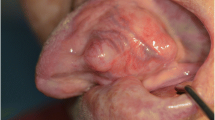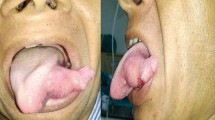Abstract
Background
Schwannoma, also known as perineural fibroblastoma, neuroma, or neurilemmoma, is a slow growing benign tumor that exceptionally raises in oral cavity. It mainly affects the second and third decade and can be life-threatening if it becomes large. Developing in youth is unusual.
Case presentation
A 16-year-old teenager presenting with relatively rapidly growing tongue base tumor which radiologic investigations revealed features of benign tumor, surgery was performed through a standard transoral approach and pathology with immunohistochemistry examination confirmed the diagnosis of schwannoma with no evidence of malignant transformation.
Conclusion
Oral cavity schwannoma is rare, and the prevailing oral location is the tongue. This particular site holds many risks related to impact symptoms or to anesthesia and securing airways. We performed a trans-oral resection of a tongue base schwannoma using a cold instrument. As the tumor is well encapsulated, this approach seems convenient and less invasive for complete surgical excision.
Similar content being viewed by others
Background
Schwannoma, also known as perineural fibroblastoma, neuroma, or neurilemmoma, is a slow growing benign tumor which arises from any nerve coated with a Schwann cell whether it is spinal, cranial, or autonomic nervous system. One of 4 cases of schwannomas occurs in the cervico-facial region with 1 to 12% of all schwannomas develop in the oral cavity mainly in the tongue [1]. It mainly affects the second and third decade and can be life-threatening if it becomes large [1]. Developing in youth is unusual [2].
We report a case of tongue base schwannoma in a teenager and discuss possible differential diagnoses, the specificity of pathology examination, and management techniques.
Case presentation
A 16-year-old male patient with no significant medical history is presented to the outpatient clinic for 3 months’ history of a firm swelling at his tongue base associated to a voice change with no other symptoms such as dyspnea, odynophagia, dysphagia, or sleep apnea. Oral cavity examination showed a 4×2 cm masse on the left posterior lateral side of the tongue, with normal-appearing overlying mucosa. This mass comes in contact with the left palato-glossal arch. No cervical lymph nodes were found. The remaining clinical examination was unremarkable. Magnetic resonance imaging (MRI) revealed a rounded shape well circumscribed mass of richly vascularized tissue measuring 3cm in long axis in the left postero-lateral side of the tongue, protruding at the level of the oropharynx (Figs. 1, 2, and 3). The patient underwent a transoral removal of the mass under general anesthesia. Perioperative findings disclosed a submucosal well-encapsulated mass with no significant vascularization (Figs. 4 and 5). The mass was completely removed through a transoral approach with cold instrument dissection and control of the tumor’s unique posterior pedicle by hemostatic forceps and surgical thread ligation. The excised mass measured 4×2 cm, had a smooth surface, white color and round shape borders. The postoperative course was uneventful, the patient did not report any significant pain or discomfort, breathing was normal, and oral feeding was allowed at J1 postoperatively. The patient was discharged from the hospital at J2 postoperatively. Microscopically, the lesion was characterized by a blending of cellular and acellular areas with the presence of Verocay bodies. Immunohistochemistry was positive for S-100 protein, confirming the diagnosis of schwannoma. The patient was first seen 1 month after surgery. He did not report any abnormal event or sensation or swallowing disorders. The patient remains asymptomatic for 6-month follow-up with no evidence of disease recurrence. Patient’s care episodes’ timeline is reported in Fig. 6.
Table 1 displays clinical, surgical techniques, and follow-up of our case and other schwannoma cases reported in literature
Discussion
Schwannoma is a benign nerve sheath tumor that mainly occurs in youth. However, all ages can be affected [1]. Male and female are approximately affected similarly [2]. The etiology of schwannomas is unknown. One quarter to half of all schwannomas cases occur in cervico-facial region. Vestibulo-cochlear nerve is the commonly most affected in head and neck region especially in neurofibromatosis [17]. In the oral cavity, schwannoma is rare (1 to 12%) [18]. Intraoral schwannomas mainly arise from the tongue, followed by the palate, mouth floor, gingiva, lip, and vestibule [18]. Usually, it presents as a painless mass in any part of the tongue of less than 2 cm. However, when the mass grows over 3 cm, compression symptoms may occur such as dysphagia, odynophagia, or swallowing discomfort, altered voice. Dyspnea is a warning manifestation that make surgical management urgent [3].
The differential diagnosis for lingual schwannoma may include neurofibroma, lingual thyroid lipoma, lymphangioma, leiomyoma, and benign salivary gland tumors [19]. However, malignant tumors such as liposarcomas, lymphoma, or carcinoma should be kept in mind. Nevertheless, malignant tumors are unlikely to present a slow growth course as typically schwannoma does. Malignant transformation of schwannoma is exceptional and mainly happens in “ancient” schwannoma according to Ackerman and Taylor [20] or in case of neurofibromatosis [2].
Imaging techniques include ultrasound scanning, CT scan, and MRI. Most schwannomas are shown at no contrast CT scan as a well-circumscribed homogeneous soft-tissue masses. MRI is the imaging modality of choice for showing the exact extent of the tumor. Therefore, it should be performed at the first place before tongue base schwannoma. MRI shows the tumor as a well circumscribed mass isointense to muscle on T1-weighted images and homogeneously hyperintense on T2-weighted images [19]. However, tumor necrosis due to the mass volume or its transformation may alter those radiologic characteristics, as in our case, the mass exhibited a hypointense T1 area of necrosis.
The exact diagnosis are suggested by fine needle aspiration biopsy, which is not always practicable, and confirmed by pathology examination [4].
Histologically, schwannomas are composed of two prototypes of cell organization called Antoni A and Antoni B. The Antoni A region is a hypercellular zone with fusiform cells that have nuclei arranged in palisade forming parallel rows and producing the Verocay bodies. The Antoni B region is a hypocellular with a loose myxoid stroma that might exhibit degenerative features, such as cysts, calcifications, hemorrhages, hyalinization, and inflammatory infiltrate. It is not common for these degenerative aspects to evolve into malignant sarcomas with invasive behaviors and metastatic potential [21]. Immunohistochemistry shows that schwannoma cells tongue exhibits strong and diffuse nuclear and cytoplasmic S-100 protein expression and extensive nuclear SOX10. Other cellular markers associated with neuronal tumors are might be present such as E.N.E., vimentin, glycoprotein, SMA, desmin, and dimentin [21].
Complete surgical excision is the main treatment modality. The transoral approach remains the most used. Other approaches were reported such as submandibular, suprahyoid pharyngotomy, trans-hyoid, and lip split approach [2]. Besides surgical approach, tongue base schwannoma presents another challenge regarding securing airways before surgery. Intubation might require the use of fibroscope or videolaryngoscope, but most importantly the hands of an experienced anesthesiologist. However, in some cases, transient tracheotomy might be performed.
Conclusion
Oral cavity schwannoma is rare, and the prevailing oral location is the tongue. This particular site holds many risks related to impact symptoms or to anesthesia and securing airways. We performed a trans-oral resection of a tongue base schwannoma using cold instrument. As the tumor is well encapsulated, this approach seems convenient and less invasive for complete surgical excision.
Availability of data and materials
The datasets generated and/or analyzed during the current study are not publicly available due to patient’s data confidentiality but are available from the corresponding author on reasonable request.
References
Enzinger FM, Weiss SW (1995) Soft tissue tumors, 3rd edn. Mosby, St. Louis
Cohen M, Wang MB (2009) Schwannoma of the tongue: two case reports and review of the literature. Eur Arch Otorhinolaryngol 266:1823–1829
Lee E-Y et al (2017) Schwannoma of the tongue: a case report with review of literature. Maxillofacial Plastic and Reconstructive Surgery 39:17. https://doi.org/10.1186/s40902-017-0116-2
Kavčič J, Božič M. BMJ Case Rep Published online: https://doi.org/10.1136/bcr-2016-215799
Haider MY, Rahim M, NMK B, Hossain MZ, Islam SMJ (2020) Schwannoma of the base of the tongue: a case report of a rare disease and review of literatures. Hindawi Case Reports in Surgery 2020:9. https://doi.org/10.1155/2020/7942062
LDR T, Koh SS, Lau SK (2020) Tongue schwannoma: a clinicopathologic study of 19 cases. Head Neck Pathol 14(3):571–576. https://doi.org/10.1007/s12105-019-01071-9
Sharma S, Rai G (2016) Schwannoma (Neurilemmoma) on the base of the tongue: a rare clinical case. Am J Case Rep 17:203–206. https://doi.org/10.12659/AJCR.897063
Nibhoria S, Tiwana K, Phutela R, Kaur J (2015) Schwannoma of tongue: a rare case presentation with review of literature. IJSS 3:147–149
Moreno-García MA, Pons-García RG-G, Monje-Gil F (2014) Schwannoma of tongue. Journal of maxillofacial and oral surgery 13(2):217–221
Bouguila J, Khalef I, Benali M, Sriha B, Soyah N, Boughammoura L (2013) Tongue base schwannoma in a child. Rev Stomatol Chir Maxillofac 114:46–48. https://doi.org/10.1016/j.stomax.2012.07.010
Lachère et al (2009) Schwannoma of the tongue: case report and literature review. Med Buccale Chir Buccale 15:195–198. https://doi.org/10.1051/mbcb/2009032
Sawhney R, Carron M, Mathog R (2008) Tongue base schwannoma: report, review, and unique surgical approach. Am J Otolaryngol 29(2):119–122
Batra K, Rai A, Chaudhary N, Topno S (2019) Two cases of neurilemmoma of the tongue. Ear Nose Throat J 86:679–681
Mehrzad H, Persaud R, Papadimitriou N, Kaniyur S, Mochloilis G (2006) Schwannoma of tongue base treated with transoral carbon dioxide laser. Lasers Med Sci 21(4):235–237
Vafiadis M, Fiska A, Panopoulou M, Assimakopoulo D (2005) A clinical case report of a schwannoma on the tip of the tongue. B-ENT 1(4):201–204
Bansal R, Trivedi P, Patel S (2005) Schwannoma of the tongue. Oral Oncol Extra 41(2):15–17
Katz AD, Passy V, Kaplan N (1971) Neurogenous neoplasms of major nerves of head and neck. Arch Surg 103:51–56
Nakasato T, Kamada Y, Ehara S et al (2005) Multilobular neurilemmoma of the tongue in a child. AJNR Am J Neuroradiol 26:421–423
Chandra M, Singh P, Venkatchalam VP (2013) Tongue Schwannoma: a case report with review of literature. JK-Practitioner 18(1–2):28–34
Ackerman LV, Taylor FH (1951) Neurogenous tumors within the thorax: a clinicopathologic evaluation of forty-eight cases. Cancer 4:669–691. https://doi.org/10.1002/1097-0142(195107)4:4<669::aid-cncr2820040405>3.0.co;2-b
Lester DR et al (2020) Head Neck Pathol 14(3):571–576. https://doi.org/10.1007/s12105-019-01071-9
Acknowledgements
Not applicable
Funding
Not applicable
Author information
Authors and Affiliations
Contributions
NO was involved in diagnosis procedures, surgery, and manuscript drafting. ML and ZT were involved in literature review and drafting of the manuscript. ZZ was involved in surgery and manuscript revision. MNA reviewed the manuscript for insightful remarks. The authors read and approved the final manuscript.
Corresponding author
Ethics declarations
Ethics approval and consent to participate
The IRB of our institution approved our study and the patient legal tutor signed the consent to participate to the study. Also, an assent to participate to the study was obtained from the patient. Our IRB is CEHUF (comité d’ethique hospital-universitaire de Fès, Email. Comite.ethique.fes@usmba.ac.ma)
The study protocol was submitted to the IRB on July 26, 2022, under the reference 18/2022. The approval was granted on August 24, 2022.
Consent for publication
An informed consent for publication purpose was obtain from the patient’s legal tutor. Written consent is available.
Competing interests
Not applicable
Additional information
Publisher’s Note
Springer Nature remains neutral with regard to jurisdictional claims in published maps and institutional affiliations.
Rights and permissions
Open Access This article is licensed under a Creative Commons Attribution 4.0 International License, which permits use, sharing, adaptation, distribution and reproduction in any medium or format, as long as you give appropriate credit to the original author(s) and the source, provide a link to the Creative Commons licence, and indicate if changes were made. The images or other third party material in this article are included in the article's Creative Commons licence, unless indicated otherwise in a credit line to the material. If material is not included in the article's Creative Commons licence and your intended use is not permitted by statutory regulation or exceeds the permitted use, you will need to obtain permission directly from the copyright holder. To view a copy of this licence, visit http://creativecommons.org/licenses/by/4.0/.
About this article
Cite this article
Ouattassi, N., Labiyed, M., Toubi, Z. et al. Tongue base schwannoma: case presentation and literature review. Egypt J Otolaryngol 39, 17 (2023). https://doi.org/10.1186/s43163-022-00355-2
Received:
Accepted:
Published:
DOI: https://doi.org/10.1186/s43163-022-00355-2










